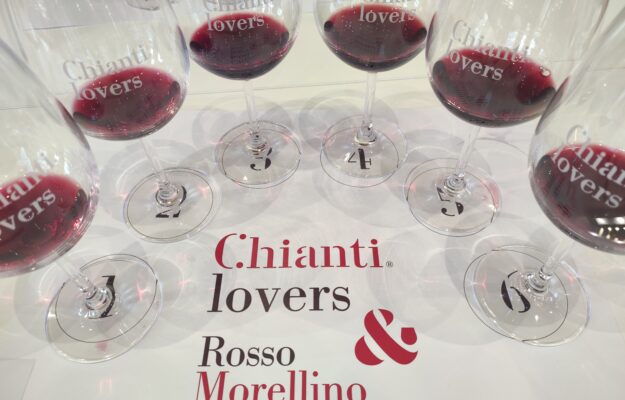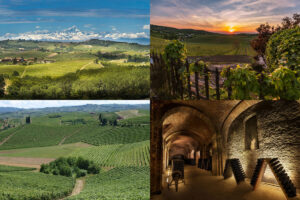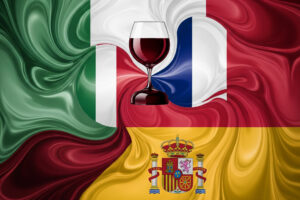Never as this year (and we are just at the beginning) has the climate emergency been the leitmotif of the “Anteprime di Toscana”: the vintages presented - 2023, 2022 and 2021 - are all characterized by some record. According to the Joint Research Centre - a Directorate General of the European Commission that deals with scientific research, in the Agricast project - an average of 15.39 degrees Celsius (°C) was recorded in Italy in 2023, compared to 15.42 in 2022, making it the two hottest years ever recorded, not counting the water deficit that has been accumulating now since 2021. The same 2021, on the other hand, according to the Lamma Consortium, Tuscany Region’s environmental monitoring and modeling laboratory, broke the record for coldest April in Tuscany, being the coldest by 1.6°C over the climate average calculated over the 30-year period 1991-2020, while June and September were among the 6 hottest since 1955. And, in the glass you can hear it, too, at “Chianti Lovers & Rosso Morellino”, which previewed their latest vintages in Florence as part of the Anteprime Toscane 2024.
Two denominations that are different in size, territory and ampelographic base, but that more than others have chosen a common path, both in promotion and daily work, both increasingly linked to direct contact with consumers, including through wine tourism. The Consorzio Vino Chianti (established in 1927) now includes 3,500 wineries working 15,000 hectares of vines claimed between 2020 and 2022 for a production of 743,000 hectoliters in 2022, which has been decreased by 30% for 2023. The appellation is divided into the provinces of Arezzo, Florence, Pisa, Pistoia, Prato and Siena, from which derive the various additional mentions: Colli Aretini, Colli Fiorentini, Colli Senesi, Colline Pisane, Montalbano, Rùfina and Montespertoli. A vast territory that produces over 100 million bottles a year, 65% of which go abroad. And which, after some difficulties (as with all red territories), is returning to positive signs, with +21% in sales in January 2024 over the same month in 2023. For the historic Maremma appellation, the Consorzio Tutela Morellino di Scansano was founded in 1992 and became DOCG in 2007. Today it has 220 members and 1,500 hectares of vineyards registered for the appellation (15% of which are registered organic), spread over a vast 65,000-hectare territory involving the municipalities of Grosseto, Magliano, Campagnatico, Roccalbegna, Semproniano and Manciano. Twenty-five percent of bottled wine (55,000 hectoliters of wine for 7.3 million bottles by 2023) travels abroad, mainly Germany and the United States, the United Kingdom, Switzerland, Northern Europe and Canada.
Two very different denominations, which, however, come to terms, like all the others, and each in their own way, with the difficulties associated with a climate that changes, inexorably. To understand what the goblet tells, however, a premise is needed. There is no doubt that a berry that ripens during a year with (more or less) regular seasons is different from a berry that goes through roller-coaster seasons in terms of temperature, solar irradiation, rainfall and drought, which accelerate or halt its development several times. And although the consortia’s consensus often decrees an “average” harvest, in terms of timing and values, lately the end result is grapes that arrive at the end of a physiological cycle in which technological and phenolic maturity no longer coincide. The choice at that point is--simplifying greatly--between harvesting grapes with still green tannins but good acidity and sugar levels, or conversely, grapes with ripe pips but low acidity and high sugar. The wines that are increasingly and widely tasted carry with them this kind of sensory edginess: high and “burning” alcohol levels, not always well integrated into the structure of the liquid, and/or immature tannins, which “dry out” the mouth and block the smoothness of the sip guaranteed by acidity.
The difference - within a generic context that undoubtedly influences the whole country - is made by geography and estate. Italy is a pedo-climatic kaleidoscope that allows infinite differences between different appellations and countless exceptions within the appellations themselves, and this can calm the most severe consequences of climatic emergency from year to year. And then there is the producer, his experience and his ability to read the vintage and his plants. That is why, within a widespread trend of more alcoholic wines and wines with scorbutic tannins, there were more balanced and convincing results, even among the 37 tasting samples of Morellino di Scansano 2023 and Morellino di Scansano Riserva 2021 and the 145 tastings of Chianti, Chianti Colli Aretini, Colli Senesi and Montalbano 2023, Chianti Colli Fiorentini, Montespertoli, Rùfina and Chianti Superiore 2022, and finally Chianti, Chianti Colli Fiorentini, Colli Senesi, Montespertoli and Rùfina in the Riserva 2021 version brought to tasting as a preview by the more than 100 wineries at the Florence event.
Looking more closely at the vintages mentioned above, 2021 had enough water supply and below-average temperatures until late May, delaying bunch development but allowing the plants to handle the decidedly warm temperatures of June, July and August. The only drawback was the April frost, which contributed to a 15% drop in the crop (when, however, 30-40% was expected ) in both appellations. Fewer bunches, then, but all in all fairly balanced, thanks in part to some late-summer rains that relieved the vines’ water stresses (and the Sangiovese grapes, which react easily to external stimuli). The 2022, the hottest year ever recorded in Italy (moreover, prolonged and droughty heat) allowed for healthy grapes to be brought to the winery, with a low use of plant protection in the vineyard. Both appellations recorded higher yields in the vineyard than the previous year. High presence of sugars resulted in significant alcohol values, not always well integrated, but the rains in late August and early September and the typical temperature ranges of the period again saved the vintage.
For 2023, in addition to the prolonged heat since June (which exceeded every monthly average until December), there is also a worrisome and widespread water shortage to report. Already the winter between 2022 and 2023 was among the warmest recorded since 1800, but at least it rained. Scarce rainfall in spring, it came in abundance in May and October (remember the floods in Romagna and Prato) on dry soils and therefore not very likely to absorb it, then distributed sparsely even in June and August. Another significant fact to record is the exceptional attack of downy mildew that affected the entire country, including Chianti and Scansano: the two appellations recorded a drop in production over 2022 of 30%t for the former and 15% for the latter.
Copyright © 2000/2025
Contatti: info@winenews.it
Seguici anche su Twitter: @WineNewsIt
Seguici anche su Facebook: @winenewsit
Questo articolo è tratto dall'archivio di WineNews - Tutti i diritti riservati - Copyright © 2000/2025








































































































































































































